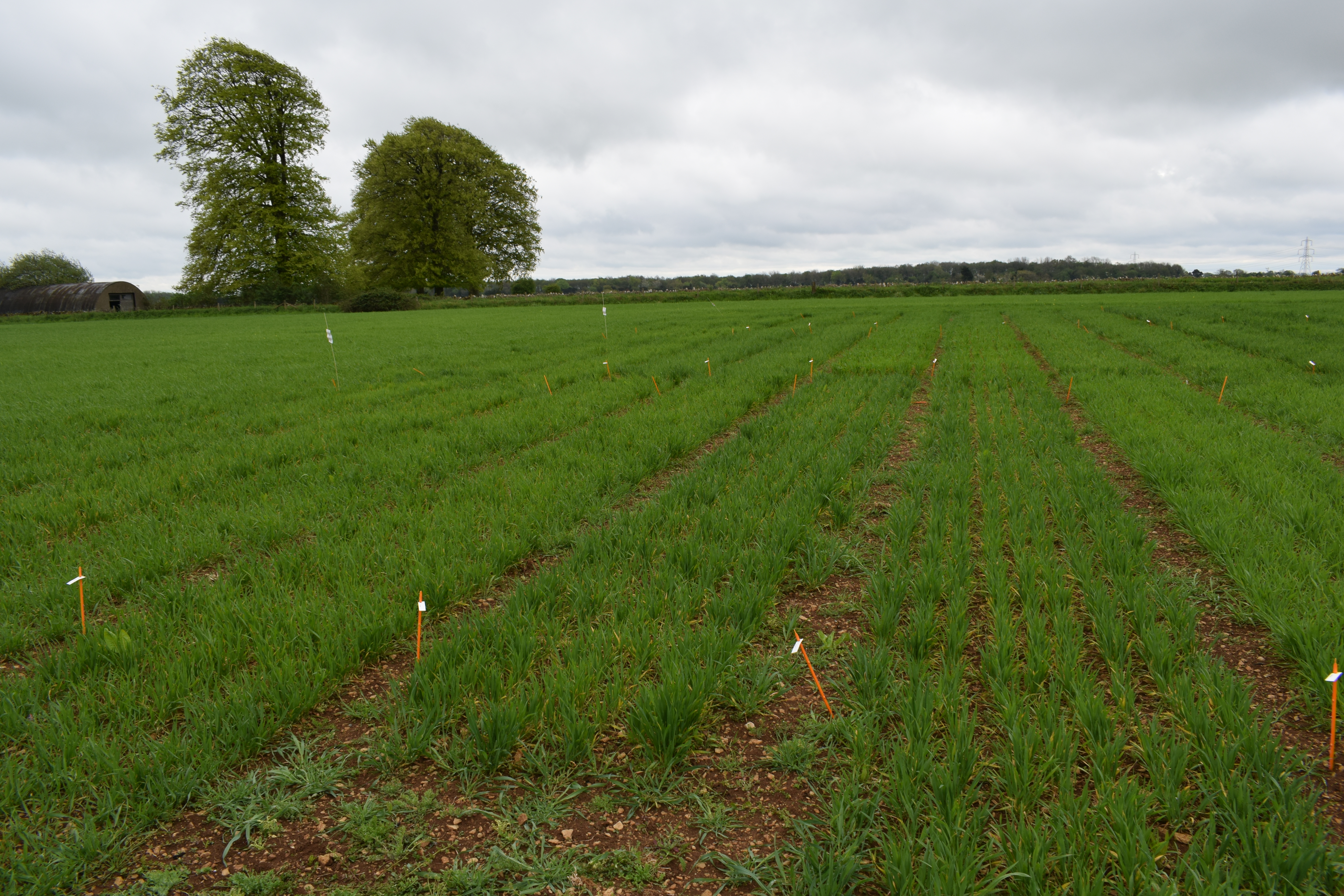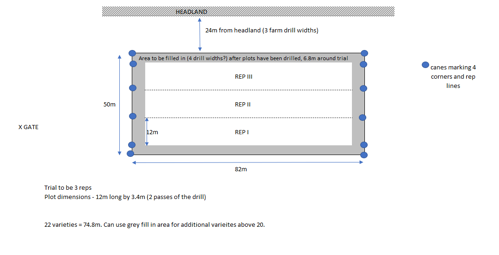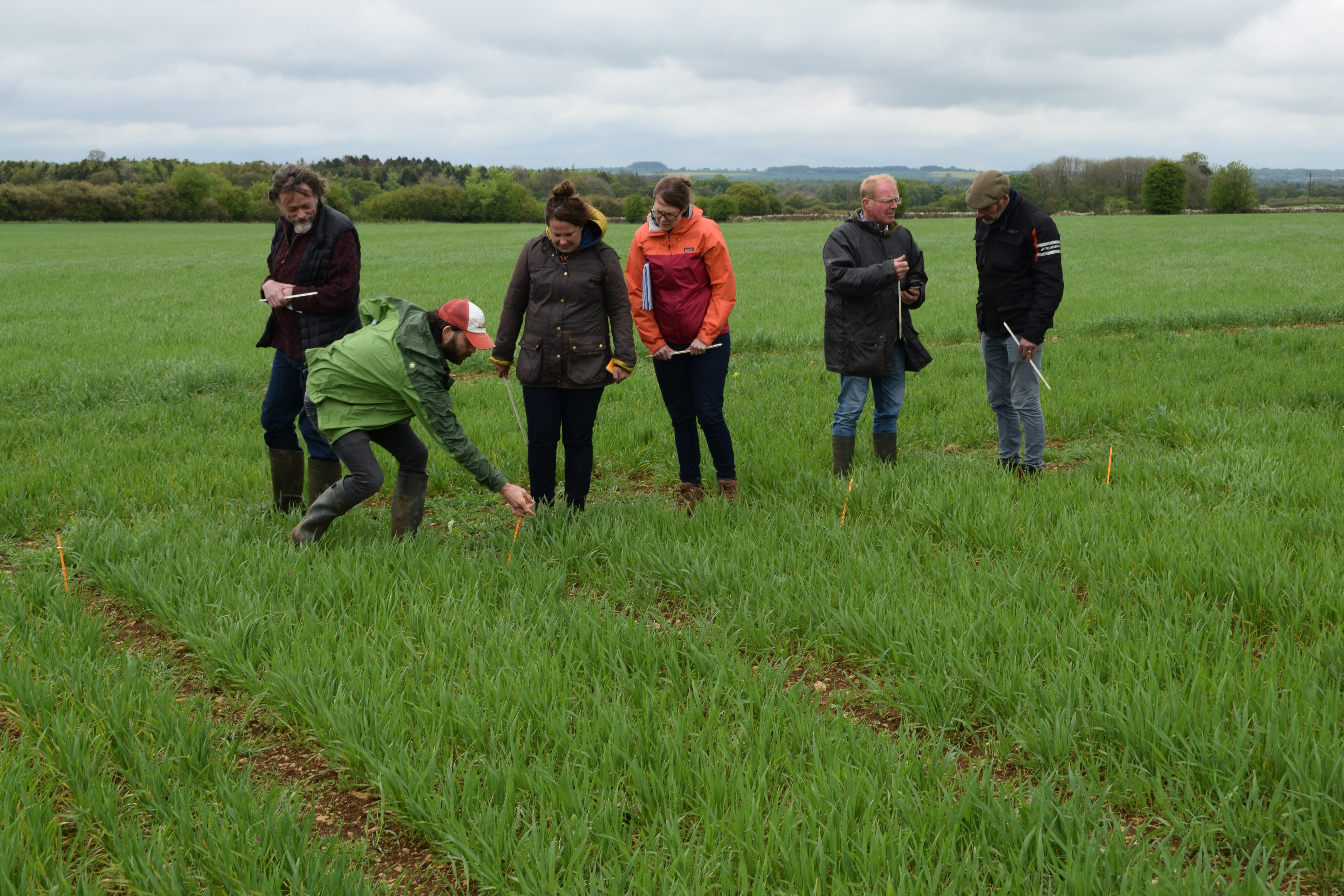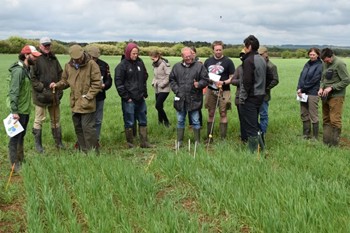
Farmers in this field lab are trialling a range of standard, new and heritage wheat varieties to assess them for use in organic systems.
A replicated trial will assess different wheat varieties in UK farming conditions for yield, milling quality and soil protecting qualities.
The varieties chosen include 14 currently grown in the UK, 2 heritage varieties, 2 from Eastern Europe and 1 new variety which is currently under development.
Pearce Seeds are also undertaking a trial in Dorset using the same varieties, and so we will be able to compare the varieties between different sites.
This will be the first coherent trial of organic wheat varieties bringing together these different arable farming groups on organic land.
Most wheat varieties are bred for conventional farming, and are trialled using full fertilizer and herbicide inputs, which is of limited relevance to organic growers.
For more information on the background to this trial go to the reports and results section of the field lab page.
During the first year this trial will be carried out on one farm and will also include a trial at a Pearce Seeds farm to help narrow down the wider group of wheat varieties. In year two, four farmers will trial these pre-tested varieties.
The trial will assess yield and quality, both bushel weight and protein levels. It will also evaluate the agronomic advantages of the varieties, with regards to weed competitiveness, disease levels by visual assessment and straw production.
In the first year the trial is designed as a randomised complete block, with 19 “treatments” and four replicates. This will ensure a high statistical power in detecting differences between varieties.
In the following year, the farmers have decided to both continue using the 3 m wide x 6 m long plots as well as including larger-scale trials e.g. half a field.
The full final report can be accessed in the Results and Reports tab on the field lab page
The four farmers in the second year of trials have now sown their multiple varieties of organic wheat as established in discussion with the researcher. The original triallist has both a field scale and plot trials, whilst the three new farmers have just plot-scale trials to lessen their risk.

Some farmers in the wider interest group of the trial are also considering including spring varieties into this trial, and propose doing this on the larger farm plots of the original triallist, rather than the small plots.
The variables and traits that are going to be assessed for both plot and farm trials are as follows:
• Pre-trial soil chemical analysis - N P K MG pH
A representative soil sample will be collected from the trial area either prior to or at drilling.
• Crop establishment – visual assessment to detect any remarkable crop failure
A simple visual assessment will take place for each plot to determine crop establishment and make varietal comparisons if evident.
• Growth cycle length - crop phenological stage in correspondence of flowering
The growth stage of each variety will be assessed using the BBCH scale at a site visit at or around mid-flowering to determine earlier or later varieties.
• Crop canopy height - on a plot basis, in correspondence of flowering (BBCH GS 65)
The canopy height will be measured using a ruler to give a representative canopy height across the plot.
• Disease severity – on a plot basis. Identification of main diseases and estimated average percentage cover of flag leaf and 2nd leaf in correspondence of BBCH GS 65
A simple percentage leaf area showing symptoms for the two leaves described will be performed
• Ear density – count of fertile tillers on two randomly selected linear row meters in each plot
Counts of ears along a row meter to provide an estimate of ear numbers per meter squared.
• Grain yield – plot/commercial combine harvest of each plot at maturity, with grain weight adjusted at 14% moisture and converted to t/ha.
Each plot (plot trial/farm trial) harvested to provide a t/ha grain yield and a moisture content to allow standardisation to 14% moisture.
• Grain quality – protein content and grain specific weight (hectolitre weight, HLW) on a 1kg sample from each plot (plot trials and farm trials) collected by the combine.

Alongside the first year triallist, another three farmers will be trialling some of the organic wheat varieties. Plot trials will run alongside larger field-scale trials, the latter which will be held in the original triallist's farm. He will also run plot-scale trials to compare to the others. The varieties chosen for the plot trials are in part selected from last year’s top yield performers in the plot trial, as well as novel material from plant breeders and seed merchants with potential for high levels of performance under organic husbandry. With more farmers trialling in this second year, potential differences in soil biota, weed profiles, disease pressure and natural fertility of organic rotations, the results of this trial will be more robust giving information to a wider reach of organic farmers.
One interesting result from last year’s plot trial was the performance of Mortimer, which demonstrated a high yield potential under organic husbandry. This variety however is no longer available commercially in the UK, with the supplier no longer carrying it, and the breeder no longer wishing to maintain it for the UK, given a lack of interest from the conventional sector. The group are keen to trial Mortimer again to substantiate its performance.
The group would like to conduct larger scale variety trials on their own farms, using their commercial farm equipment and own farm management and environment to give a more relevant evaluation of varietal performance for their own farms. This larger scale farm variety trial will be coordinated to give proper comparisons by designing the trial to an incomplete block design, with multiple comparisons taking place across farms.
Plot trial data and farm trial data will be compared to assess which if either is more useful in providing farmers with information to make management decisions and varietal choices. Both approaches should compliment each other to give a more thorough evaluation of variety performance.
The trial will assess yield and quality, both bushel weight and protein levels. It will also evaluate the agronomic advantages of the varieties, with regards to weed competitiveness, disease levels by visual assessment and straw production.
The 2018/19 plot trial will be a randomised complete block design (22 varieties, 12 m by 3.4 m plots, replicated 3 times).
The plot trials will include the following varieties;
YQ, Ehogold, Siskin, Crispin, Montana, Evolution, Revelation, Zyatt, Skyfall, Crusoe
Edelmann, Mortimer, Extase, Moschus, Cougar, Halfreda, AWC1, AWC2, AWC3 and AWC4, Costello, and Maris Widgeon.
The farm trials will include the following varieties;
Revelation, Ehogold, Skyfall, Crusoe, Zyatt and Crispin
The reasoning behind each variety’s inclusion encompasses several factors, with the list aiming to represent current commercial organic, novel, heritage and developmental varieties to properly represent the winter wheat variety portfolio in the UK.
For more information on the year 2 trial design see the reports and results section of the website page
The full report on the first year results can be found in the Results and Reports tab on the field lab page.
Conclusions about varietal performance must be taken cautiously because the trial has been run for one year only. However, this trial has a value outside its results as it embeds all the pros and cons aspects of a plot trial. In fact, the general underperformance of wheat in this trial is in part linked to the plot structure itself and to its artefacts (especially machinery not representative of farm machinery, delays in drilling due to availability of the plot drill): the average yield of the trial was evidently lower than the yield of the surrounding commercial field of variety Revelation, which was about 3.8 t/ha, i.e. 58% more than the same variety in the plots. However, a plot trial is the only way to compare a relatively large number of varieties in the same environment and to draw a general profile of their performance. For example, specific constraints in terms of diseases have been identified, and correlation between yields and quality are possible without other “confounding” variables.
Merging data from this trial with the data from the parallel trial run by Pearce Seeds in Dorset will strengthen both trials, confirming and/or correcting the trends identified. Testing a restricted number of varieties at a field scale with a network of farmers, whilst maintaining a reference plot trial is by far the best compromise to draw conclusions about varietal performance in organic systems.

The results of the first year of trials including 17 different varieties of organic wheat have been analysed:
Height and disease
Crop observation during the flowering stage highlighted differences among varieties in terms of height and disease susceptibility. Maris Widgeon had an outstanding canopy height (82.5 cm on average) compared to the bulk of the other varieties, all ranging between 57 and 67 cm.
We observed presence of the three major foliar diseases:
• Septoria was observed in all varieties except Crusoe and Skyfall, with relatively low severity not exceeding 11%, and with no significant differences among the affected varieties;
• Yellow rust was only present in variety Skyfall with a high severity of 43%;
• Brown rust affected with a medium severity var. Crusoe (10%).
Yield
The average grain yield was 2.25 t/ha. Yields spanned across a range between a minimum of 1.78 t/ha of var. Anapolis, and a maximum of 2.80 t/ha of var. Mortimer at 430 seed/m2. However, statistical analysis did highlight significant differences between varieties (Anova p = 0.001, Tukey’s minimum significant difference = 0.82 t/ha) with Mortimer (lower seed rate) yielding significantly better than Zyatt, Anapolis and AWC13. Protein and specific weights were low compared to optimal values, with 6.14% and 65.6 kg/hl on average, respectively.
Protein content and yield are linked by a highly significant negative correlation (r = - 0.87; p = 0.000 ***), with the lowest protein content detected in the top yielding variety and vice-versa. Observing the distribution of varieties across a trendline representing this trade-off, we can suggest that varieties Olympus, Siskin and Skyfall fell below the trendline, therefore with lower protein than expected according to their yield, whereas varieties Maris Widgeon, Graham and Gourmet tended to be above the trendline, suggesting that they could have been more efficient in harvest.
At the recent meeting 12 farmers attended to discuss the trials progress and look at the variety of organic wheat being grown. Of this group, most will start trialling their preferred varieties from autumn onwards, expanding on this initial year of trials.
Observations by the lead triallist and the group were that the trial plot is not as thick as normal crops due to delays at drilling caused by wet weather. It looks as though none of the varieties have suffered more than others due to this and the current persisting dry weather - an interesting results in itself. The current trial is 2-3 weeks away from harvesting, after which yield data will be collected.
Having viewed the trial plots, the group discussed the role of smaller plots trials (as utilised this year in 3 m x 6 m plots) and using larger-scale tramlines for trialling new varieties and which is the best method for making farm management decisions. It was felt that both methods of trialling are needed - the initial plot trials are useful for a 'look-see' first before expanding onto a larger scale. In the second year of trials larger part-field tramlines will be used in order to scale up growing the selected varieties. There was also conversation about carrying on using the existing plot trials to try out further varieties, which could also include organic varieties of oat, spring barley and other grains.
The group will hold a further meeting after the results come through, during which they will each decide what varieties they would like to trial next year.
The trial will assess yield and quality, both bushel weight and protein levels. It will also evaluate the agronomic advantages of the varieties, with regards to weed competitiveness, disease levels by visual assessment and straw production.
Initially the trial will run on one farm and also include a trial at a Pearce Seeds farm. This is a trial run to narrow the varieties down ahead of expanding the trial across other farms. Fourteen farmers will then have the opportunity to trial these pre-tested varieties, and are currently involved in the progress of the initial trial in preparation for the following year.
The trial will be a replicated trial (16 varieties each with 10 by 4 m plot, each variety replicated 4 times).
The list of varieties includes:
Olympus
Anapolis
Sundance
Crispin
Graham
Costello
Siskin
Dunstan
Gleam
Zyatt
Skyfall
Maris widgeon
Crusoe
AWC 13
Mortimer
Gourmet
Analysis
• Yield will be taken at harvest.
• Quality lab and protein level ‘gluten quality’ at lab for milling, bushel weight on combine, yield plot combine.
• Pre-trial soil tests have been carried out on N P K Mg and pH.
Trial Design
In the first year the trial is designed as a randomised complete block, with 19 “treatments” and four replicates. This will ensure a high statistical power in detecting differences between varieties.
In the following year, the farmers have decided to both continue using the 3 m wide x 6 m long plots as well as including larger-scale trials e.g. half a field.
Field Analysis
The variables and traits that are going to be assessed are as follows:
Pre-trial soil chemical analysis (including N, P, K, MG and pH): A representative soil sample will be collected from the trial area either prior to or at drilling.
Crop establishment: A visual assessment for each plot to detect any remarkable crop failure
Growth cycle length (crop phenological stage in correspondence of flowering): The growth stage of each variety will be assessed using the BBCH scale at a site visit at or around mid-flowering to determine earlier or later varieties.
Crop canopy height (on a plot basis, in correspondence of flowering (BBCH GS 65)): The canopy height will be measured using a ruler to give a representative canopy height across the plot.
Diseases severity: Identification of the main diseases and estimated average percentage cover of flag leaf and 2nd leaf in correspondence of BBCH GS 65 in each plot. A simple percentage leaf area showing symptoms for the two leaves described will be performed.
Ears density: A count of fertile tillers on two randomly selected linear row meters in each plot, to provide an estimate of ear numbers per meter squared.
Grain yield: A combine harvest of each plot at maturity, with grain weight adjusted at 14% moisture. Each plot harvested to provide a kg/plot grain weight and a moisture content to allow conversion to t/ha and standardisation to 14% moisture.
Grain quality: Protein content and grain specific weight (hectolitre weight, HLW) on a 1.5Kg sample from two replicates of each variety, collected by the combine.
Statistical Analysis
Statistical analysis will be carried out at the Organic Research Centre following a RCB linear model for every variable and detecting significant correlations between different variables. This will better highlight the relevance of specific traits to varietal performance. Jointly analysing data from the ‘sister trial’ in Dorset will enable a multi-location analysis to enhance and thereby increase the predictive power of the results. The open source ‘R’ software, with all relevant packages, will be used for statistical analysis and results elaborations.
As the trial expands to include additional farms next year, it is expected that each farmer will be able to tailor the trial to fit in with their own farming systems, using their own farm equipment – as would be necessary to take on the use of a new variety.
As the trial expands to further farms next year, it is expected that each farmer will be able to tailor the trial to fit in with their own farming systems – as would be necessary to take on the use of a new variety.
October 2017
November 2017
February 2018
May 2018
September 2018
October 2018
October 2018
October 2018
December 2018
March 2019
June 2019
July 2019
August 2019
September 2019

Soil Association
Bristol / UK-wide
Arable & Soils Advisor at Soil Association, and farmer. I ran the family farm in Devon for 25 years, farming dairy, then organic beef, sheep and arable units with holiday cottage conversions. Former chairman of a local farmer owned co-op grain store, and involved in the grain supply chain nationally.

Organic Research Centre
Cirencester

In this section you will find reports and results from the field lab, as well as other relevant documents.

